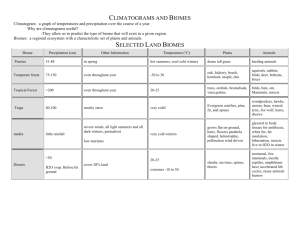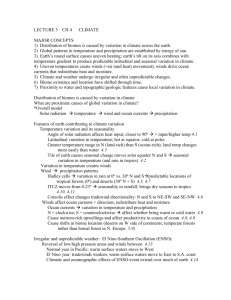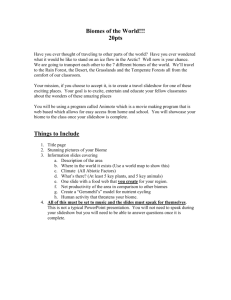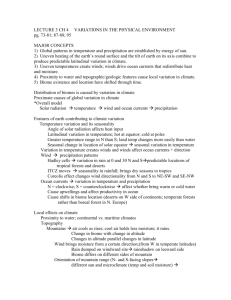C7 Climate & Terrestrial Diversity
advertisement
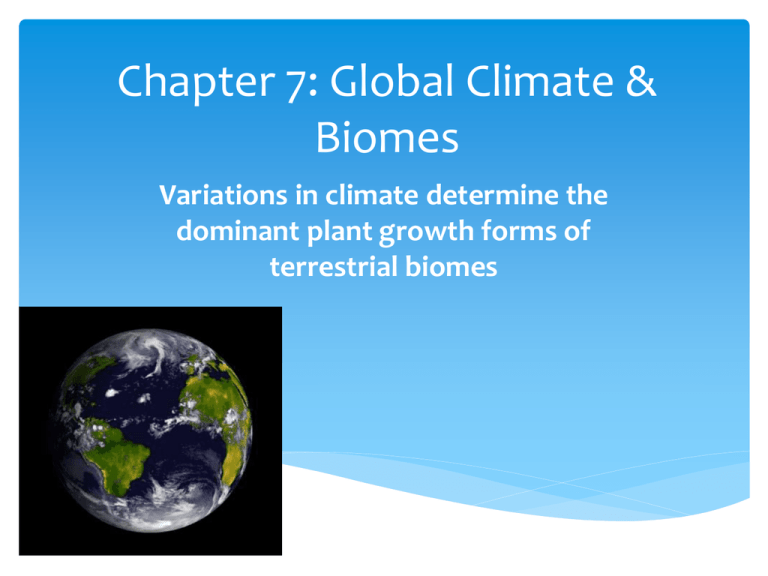
Chapter 7: Global Climate &
Biomes
Variations in climate determine the
dominant plant growth forms of
terrestrial biomes
Variations in climate determine the dominant
plant growth forms of terrestrial biomes
Objective(s):
SWBAT explain the forces that drive global
circulation patterns and how those patterns
determine weather & climate.
SWBAT describe the unequal heating of the
Earth.
SWBAT diagram the atmospheric circulation of
the Earth.
SWBAT describe the coriolis effect.
Variations in climate determine the dominant
plant growth forms of terrestrial biomes
Objective(s):
SWBAT describe gyres & upwelling.
SWBAT summarize El Nino oscillation.
SWBAT summarize the major terrestrial
biomes.
SWBAT analyze climate diagrams.
C7: Global Climate
Layers of the Atmosphere
Thermosphere: largest span of
altitude; blocks harmful X-ray and UV
radiation.
Mesosphere: Middle layer.
Stratosphere: Ozone layer absorbs
most of the UV-B radiation
Troposphere: layer closest to the
Earth. Densest layer of the
atmosphere containing most of the
nitrogen, oxygen and water vapor.
Almost all weather occurs here.
C7: Global Climate
Chapter 7: Global Climate
Weather - the short term conditions of the
atmosphere in a local area. These include
temperature, humidity, clouds, precipitation,
wind speed and atmospheric pressure.
Climate - The average weather that occurs in a
given region over a long period- typically
several decades to thousands of years
C7: Global Climate
C7: Global Climates
Climate varies in different parts of the Earth
due to:
Patterns of global air circulation
Ocean currents
This distributes heat and precipitation
unevenly
Chapter 7: Global Climates
3 Major Factors affect air circulation in the lower
atmosphere:
Variation in angle at which the Sun’s rays strike the
Earth (unequal heating of earth’s surface)
Chapter 7: Global Climates
3 Major Factors affect air circulation in the
lower atmosphere:
Rotation of the Earth on its axis.
Earth’s Rotation on its axis
Earth’s Rotation & Coriolis effect
As Earth rotates, its surface moves much faster at
the equator than in the mid-latitude regions and
polar regions due to the variation in the
circumference of the Earth’s surface.
Coriolis effect: the deflection of an object's path due
to Earth's rotation.
Chapter 7: Global Climates
3 Major Factors affect air circulation in the
lower atmosphere:
Some areas of the Earth reflect more solar energy
than others. (properties of air, water and land)
Albedo: The percentage of incoming light that is reflected from the
surface. The higher the albedo of a surface, the more solar energy
is reflected and the less that is absorbed.
Albedo Averages
Albedo
C7: Global Climates
Properties of air that influence its movement:
Density: Less dense air rises. Warm air has a lower
density than cold air, so warm air rises.
Water Vapor Capacity: Warmer air has a higher
capacity for water vapor than cold air.
Saturation Point: The maximum amount of water
vapor that air will retain at a given temperature
Atmospheric Global Circulation
Polar Cell: convection
currents formed by air
that rises at 60° N & S
and sinks at the poles.
Mid-Latitude Cell
(ferrel cell): convection
currents between 30°
& 60°
Hadley Cells:
convection currents
between the equator
and 30° N & S
**Regions at30° N & S
are typically, hot, dry
deserts
C7: Global Climates
The prevailing winds systems of the world are
produced by:
Atmospheric convection currents
Coriolis Effect
http://video.pbs.org/video/2365036901/
https://www.youtube.com/watch?v=Pb69HENUZs8
https://www.youtube.com/watch?v=dt_XJp77-mk
https://www.youtube.com/watch?v=i2mec3vgeaI
Earth’s Tilt and the Seasons
Earth’s axis of rotation is tilted at 23.5˚,
therefore Earth’s orbit around the sun causes
most regions of the world to experience
seasonal changes in temperature and
precipitation. (causes seasons)
Ocean Currents
Ocean currents are driven by a combination of
temperature, gravity, prevailing winds, the Coriolis
effect, and the locations of continents.
Warm water, like warm air, expands and rises.
Gyres- the large-scale patterns of water circulation.
The ocean surface currents rotate in a clockwise
direction in the Northern Hemisphere and a
counterclockwise direction in the Southern
Hemisphere.
Ocean currents can affect the temperature of nearby
land masses.
5 Major Gyres Worldwide
SUBTROPICAL GYRES, Form at Center of Subtropical High Pressure
Diagram reinforces how Coriolis Effect Causes Cold Water Upwelling as well
As more plastic trash flows from…
…our watersheds to the sea, scientists are finding that plastic debris is
accumulating in the each of the 5 oceanic gyres. Research conducted by the
Algalita Marine Research Foundation highlighted the “Pacific Garbage Patch”, –
an area of plastic accumulation in the North Pacific between California and Hawaii.
Studies by the Sea Education Association, (SEA), in the Atlantic have documented
plastic pollution in the North Atlantic Gyre.
Fish Ingestion of Plastic
http://vimeo.com/8306883
Planet 100
https://www.youtube.com/watch?v=xc6LvdsyJ4U
Charles Moore
https://www.youtube.com/watch?v=en4XzfR0FE8
Ocean Pollution Awareness
https://www.youtube.com/watch?v=1qT-rOXB6NI
5 Gyres Research Team
5 Gyres Team Website: http://5gyres.org/
Upwelling
Upwelling - as the surface currents separate from
one another, deeper waters rise and replace the
water that has moved away.
This upward movement of water brings nutrients
from the ocean bottom that supports the large
populations of producers, which in turn support
large populations of fish.
Thermohaline Circulation
Thermohaline circulation- oceanic circulation that
drives the mixing of surface water and deep water.
Crucial for moving heat and nutrients around the
globe and can take hundreds of years to complete.
Thermohaline Circulation
1. Warm water flows from the Gulf of Mexico to the North
Atlantic, where some of it freezes and evaporates.
2. The remaining saltier, denser water sinks to the ocean
bottom.
3. The cold water current travels along the ocean floor,
connecting the world’s ocean.
4. The cold, deep water eventually rises to the surface in
the North Pacific and circulates back to the North
Atlantic
Thermohaline Circulation
(ENSO): Every 3 to 7 years, the interaction of the Earth's
atmosphere and ocean cause surface currents in the tropical
Pacific Ocean to reverse direction.
El Nino Southern Oscillation (ENSO)
Trade winds near South America weaken.
This allows warm equatorial water from the western Pacific to
move eastward toward the west coast of South America.
Movement of warm water & air toward South America
suppresses upwelling off the coast of Peru and decreases
productivity there, reducing fish populations near the coast.
These periodic changes in wind and ocean currents are
collectively called the EL Nino-Southern Oscillation, or ENSO.
EL Nino Southern Oscillation (ENSO)
Impact of ENSO globally:
Cooler and wetter conditions in the SE USA
Unusually dry weather in South Africa and SE Asia
Global Circulation Patterns
during El Nino
Rain Shadows
When air moving inland from the ocean containing a large
amount of water vapor meets the windward side of a mountain
range , it rises and begins to experience cooling.
Because water vapor condenses as air cools, clouds form and
precipitation falls.
The presence of the mountain range causes large amounts of
precipitation to fall on its windward side.
Cold, dry air then travels to the other side of the mountain range
(the leeward side), descends and warms, releasing little moisture
resulting in semiarid or arid conditions
Rain Shadows
Variations in climate determine the dominant
plant growth forms of terrestrial biomes
Climate affects the distribution of species around the
globe.
Organisms possess distinct growth forms due to
adaptations to local temperature and precipitation
patterns.
Biomes- The presence of similar plant growth forms in
areas possessing similar temperature and precipitation
patterns.
Biome Locations
Biomes: Arctic Tundra (Cold Grasslands)
Temperatures Range by Season (-34º C 12ºC)
Rainfall (15 – 25 cm/yr)
Specific Abiotic Factors: Soggy Summers,
permafrost; cold & dark much of year
Plants: Treeless, Short grasses & shrubs
Animals: Caribou, polar bears, wolves,
birds, insects, salmon, trout
Biomes: Arctic Tundra (Cold Grasslands)
Cold, treeless biome with low-growing vegetation. In
winter, the soil is completely frozen.
The tundra's growing season is very short, usually only
about 3 months during summer.
The underlying subsoil, known as permafrost is an
impermeable, permanently frozen layer that prevents
water from draining and roots from penetrating.
Biomes: Boreal Forest
(Evergreen Coniferous Forest)
Cool Temperatures (-54º C - 21ºC)
Rainfall (30 – 84 cm/yr)
Specific Abiotic Factors: Summers are
short & moist, winters are long, cold & dry
Plants: Spruce & Fir trees, Deciduous trees
Animals: moose, beavers, deer, mountain
lions, birds, & wolverines
Biomes: Boreal Forest
(Evergreen Coniferous Forest)
Forests made up primarily of coniferous (cone-bearing)
evergreen trees that can tolerate cold winters and short
growing seasons.
Boreal forests are found between about 50˚ and 60˚ N in
Europe, Russia and North America.
This subarctic biome has a very cold climate, and plant
growth is more constrained by temperature than
precipitation.
The soil is nutrient-poor due to slow decomposition.
Temperate Rainforests
Our Local Temperate Rainforest
Temperate Rainforests
Moderate temperatures and high precipitation typify the temperate
rainforest.
The temperate rainforest is a coast biome and can be found along the west
coast of North America from northern California to Alaska, in southern
Chile, on the west coast of New Zealand, and on the island of Tasmania.
The ocean currents help moderate temperature fluctuations and provide a
source of water vapor.
This biome has a nearly 12-month growing season where winters are rainy
and summers are foggy.
The mild temperatures and high precipitation supports the growth of very
large trees.
Biomes: Temperate Seasonal
(deciduous) Forest
Temperatures Range by Season
(Winter: -30º C - 25ºC/Summer: )
Moderate Rainfall (75 – 150 cm/yr) {most
during spring}
Specific Abiotic Factors: Well defined
seasons; Summers are hot, winters are cold
Plants: Oak, Beech and Maple Trees (drop
leaves in fall)
Animals: squirrels, rabbits, skunks, deer,
birds, deer, foxes, black bears, raccoons
Temperate Seasonal Forest
Receive over 1 m (39 inches) of precipitation annually.
Found in the eastern United States, Japan, China, Europe,
Chile and eastern Australia.
Dominated by broadleaf deciduous trees such as beech,
male, oak and hickory.
Warmer summer temperatures favor decomposition so
soils generally contain more nutrients than those of
boreal forests.
Temperate Shrubland/Chaparral
Found on the coast of southern California, southern Australia,
southern Africa and in the area surrounding the Mediterranean Sea.
Hot, dry summers and mild, rainy winters are characteristic of this
biome.
There is a 12-month growing season, but plant growth is constrained
by low precipitin in summer and by relatively low temperatures in
winter.
Wildfires are common and plants of this biome are well adapted to
both fire and drought.
Temperate Shrubland/Chaparral
Temperatures Range by Season (10º C 40ºC)
Rainfall (38 – 100 cm/yr){mostly in winter}
Specific Abiotic Factors: Summers are very
dry and hot, winters are cool and wet
Plants: Oaks (deciduous and evergreen)
Animals: foxes, jackrabbits, birds, bobcats,
lizards, snakes
Biomes: Temperate Grassland
Temperatures Range by Season (-40º C 38ºC)
Moderate Rainfall (50 – 89 cm/yr)
Specific Abiotic Factors: Summers are hot,
winters are cold
Plants: Grasses and herbs
Animals: gazelles, bison, deer, mice, coyotes,
Foxes, wolves, birds, snakes, grasshoppers,
spiders
Temperate Grassland
This biome has the lowest average annual precipitation of any
temperate biome. (25cm - 90 cm)
These are found in the Great Plains of North America, in South
America, and in central Asia and eastern Europe.
Cold, harsh winters and hot, dry, summers characterize this biome.
Plant growth is constrained by both insufficient precipitation in
summer and cold temperatures in winter.
Plants include grasses and non woody flowering plants that are
well adapted to wildfires and frequent grazing by animals
Biomes: Tropical Rain Forest
Warm Temperatures (24º C - 26ºC)
Abundant Rainfall (200 – 1000 cm/yr)
Specific Abiotic Factors: humid all year, hot & wet
Plants: Broadleaved Evergreens, Bamboo, Sugar
Cane
Animals: Elephants, Sloths, Elephants, Cobras
Tropical Rain Forest
In the tropics, average annual temperatures exceed 20˚C.
This biome is located approximately 20˚ N and S of the equator.
They are found in Central and South America, Africa, Southeast Asia,
and northeastern Australia.
Precipitation occurs frequently and this biome is warm and wet with
little temperature variation.
Tropical rain forests have more biodiversity per hectare than any other
terrestrial biome and contain up to two-thirds of Earth's terrestrial
species.
Biomes: Tropical Seasonal Forest
(Savanna)
Warm Temperatures (20º C - 30ºC)
Moderate Rainfall (50 – 130 cm/yr) {mostly during
the rainy season}
Specific Abiotic Factors: Summers are hot & rainy,
winters are cool & dry
Plants: Grasses, scattered trees
Animals: Lions, hyenas, elephants, cheetahs,
zebras, birds, insects
Tropical Seasonal Forest (Savanna)
Warm temperatures and distinct wet and dry seasons
characterize this biome.
Tropical seasonal forests are common in much of Central
America, on the Atlantic coast of South America, in southern
Asia, in northwestern Australia, and in sub-Saharan Africa.
Soil in this biome is fairly fertile and can be farmed due to high
decomposition rates, but the low amount of precipitation
constrains plants from using the soil nutrients that are released.
Grasses and scattered deciduous trees are common.
Biomes:
Subtropical Desert
Range in Temperature: {High: 20º C - 49ºC
Low: -18º C – (-10ºC )}
Low Rainfall (2 – 26 cm/yr)
Specific Abiotic Factors: varying temps, low rainfall
Plants: Cacti, Joshua Trees, Succulents
Animals: Lizards, Bobcats, birds, tortoises, snakes,
antelope, desert toads, rats, ground squirrels
Subtropical Desert
This biome is found at 30˚ N and S with hot temperatures
and extremely dry conditions.
The Mojave Desert in the southwestern United States, the
Sahara in Africa, the Arabian Desert of the Middle East and
the Great Victoria Desert of Australia are all subtropical
deserts.
Cacti, euphorbs and succulent plants are well adapted to this
biome.
